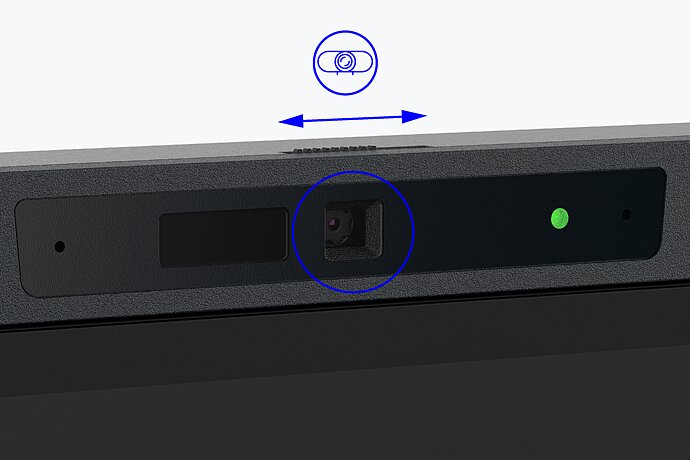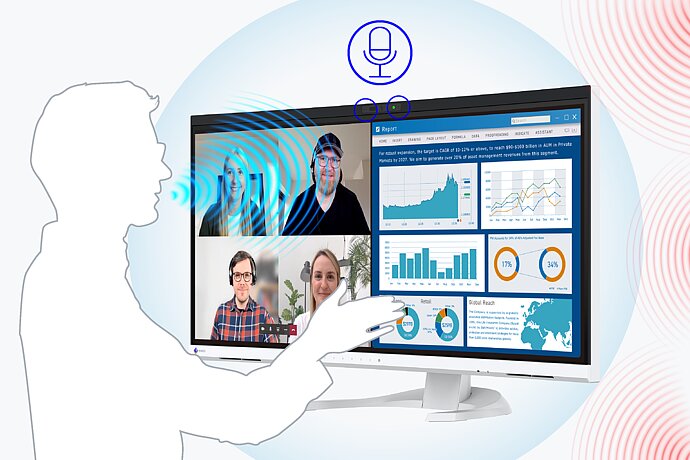Regardless of whether you work in the office or from home, the demands on your work performance remain the same. That's why we believe that you should also work with the same high-quality equipment in your home office.
We therefore summarize the most important tips and recommendations for selecting suitable workstation monitors in the home office and explain the key technical features.
Tips and recommendations
The right monitor for the home office
The right monitor helps you to work just as productively and ergonomically in your home office as in the office.

Content of this page
- The conditions must be right
- Screen diagonal and resolution
- The notebook as an additional screen
- Video conference monitor with integrated webcam
- The right connections
- The ergonomic workplace
- Sustainable and economical monitors
- Product recommendations for the home office
- Sources of supply and contact options
Monitors in the home office
The conditions must be right

Everyone knows that the conditions have to be right for efficient and, above all, healthy working. At least when it comes to office workplaces in companies. There are often occupational health regulations that are regularly monitored. It is also clear to everyone that the same standards of comfort and ergonomics should also apply in the home office, but unfortunately the reality is often very different.
Many people work at home on small notebook screens that offer neither the size nor the ergonomic adjustment options that one would naturally expect from a modern and healthy workstation in a company.
We are convinced that the best work can only be done with the best tools and that there are many reasons why an external workstation monitor belongs in every home office.
Monitors in the home office
Screen diagonal and resolution
External monitors with a large screen diagonal have a clear advantage over notebooks due to their size alone: for most office tasks, it is important that screen content is displayed clearly and legibly, especially when multitasking with different programs. An external monitor can easily accommodate several application windows next to each other and windows can be arranged clearly next to each other. Working with such desktop monitors makes work more efficient, more comfortable, saves valuable time and is also more ergonomic.
Resolution and pixel density
The measure of detail resolution is ppi (pixels per inch), i.e. pixels per inch. This value describes the distance between the individual pixels and is therefore also referred to as pixel density. The rule of thumb is: the higher the pixel density, the finer the details that can be displayed on the monitor and the sharper the image display.
For an optimally sharp display, we recommend screens with the highest possible resolution. This is because the higher the resolution, the higher the pixel density. When comparing screens of devices with the same diagonal, it is therefore crucial to look at the resolution in order to significantly increase readability.
Some users shy away from high-resolution monitors because they are concerned that the higher detail resolution will also reduce the size of the typeface or user interface. This problem is now a thing of the past. Operating systems and programs offer scaling functions that allow you to enlarge fonts and menus according to your preferences. This allows you to enjoy a sharp display without having to sacrifice your usual font size.
Which resolution for which screen diagonal?
We recommend the following resolutions for the individual screen sizes:
23/24-inch monitors
On 16:9 screens with 1920 × 1080 pixels, this is referred to as Full HD resolution. 23/24-inch screens with an aspect ratio of 16:10 have a resolution of at least 1920 × 1200 pixels (WUXGA). The extra lines can be more convenient for you because you have to scroll less and can, for example, edit two A4 pages side by side in almost their original size.
27-inch monitors
27-inch models should have a resolution of 2560 × 1440 pixels (WQHD), preferably 3840 x 2160 (also known as UHD-4K). This pleasant combination of screen diagonal and resolution offers much more space for working compared to Full HD - especially if you use several windows at the same time.
32/34/38-inch monitors
High resolutions and aspect ratios from 16:9 to 21:10 offer you an enormous amount of space for an optimal division of the screen area and display size of your content.
A tip regarding large screen diagonals: curved monitors support a comfortable view with inch sizes such as 34 inches and 38 inches. In contrast to a completely flat surface, the curvature of the monitor makes it easier to see the side areas of the screen.
Of course, exceptions prove the rule here too. For special applications such as graphic design or CAD/CAM, for example, we generally recommend "4K" or "UHD" resolutions.

MONITORS IN THE HOME OFFICE
The notebook as an additional screen
Although using the built-in notebook display alone is not ideal for day-to-day work, it is all the more valuable as a supplement to the external monitor. If you open your notebook (ideally with an external mouse and keyboard) and position it next to your monitor and use the "Extend desktop" setting, your usable monitor space will increase considerably.

More workspace thanks to additional screens
MONITORS IN THE HOME OFFICE
Video conference monitor with integrated webcam
Working from home, remote working and hybrid meetings are part of the modern working world. A monitor with an integrated webcam is ideal for video conferences and online meetings. If a microphone, speakers and USB-C and LAN connections are also integrated, the monitor becomes a true communication hub for virtual meetings.
The Curved Ultrawide FlexScan EV3450XC from EIZO offers these and other features. With an integrated, high-resolution 5 MP webcam, built-in microphone with noise and echo suppression and feedback-free speakers, it is fully equipped for video conferencing.
MONITORS IN THE HOME OFFICE
The right connections
Working in different locations is becoming more and more commonplace. This makes it all the more important that you can set up your workstation quickly and conveniently at any time. Thanks to maximum connectivity, EIZO monitors allow you to do just that.
Many of our models have a USB-C port that allows you to easily connect all your devices (mouse, keyboard, webcam, etc.) and transfer all conceivable image, audio and data signals. Incidentally, you no longer need a separate power supply unit for your laptop: the notebook power supply is also provided via USB-C at the same time.
If you use a different graphics connection, an additional USB cable is required. In both cases, the right monitor can make an additional docking station superfluous.
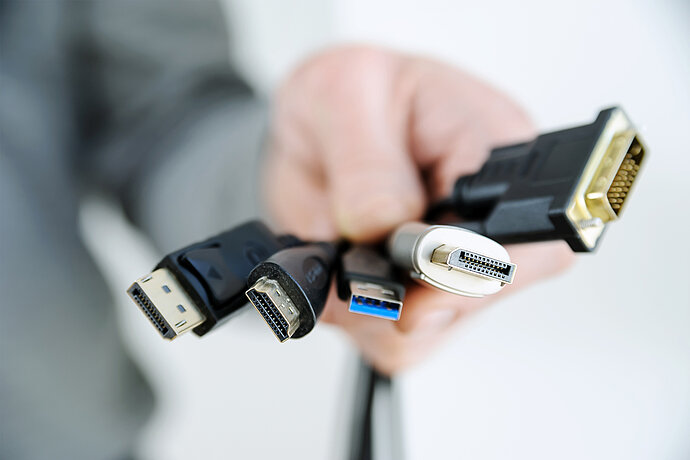
Image and audio signals
In order for the selected monitor to function optimally on the respective computer, a suitable graphics output must be available for the image output in the desired resolution and with the correct signal type. For resolutions above Full HD, the following connections are recommended: HDMI, DisplayPort, Mini-DisplayPort or USB-C. To choose the right monitor, it is therefore crucial to check the available video outputs on the computer.
Three types of connections are commonly used on monitors: DisplayPort, HDMI and USB-C. Sometimes connections of the older DVI type are also available.
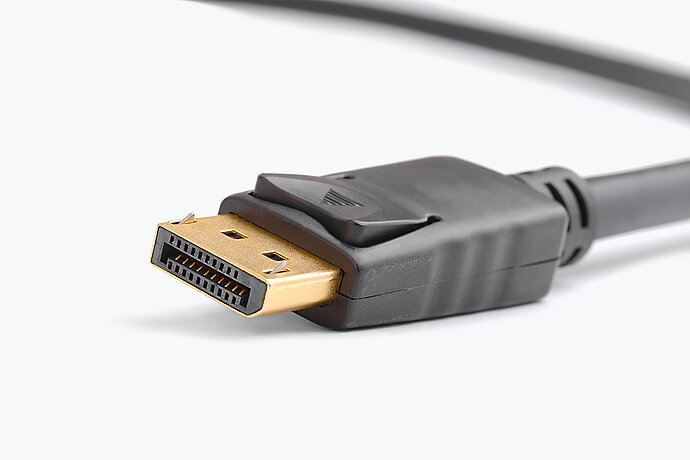
DisplayPort (DP) or Mini DisplayPort (Mini DP)
Computers with DisplayPort (DP) or Mini DisplayPort (Mini DP) connections are ideally suited, as these outputs easily support higher resolutions with high refresh rates. The sound is also transmitted directly if this is important for the intended use.
Such end devices can be easily connected to modern monitors, which are generally always equipped with "normal" DisplayPort connections. If your computer uses a Mini DP output, you will need an adapter cable from Mini DisplayPort to DisplayPort.

High Definition Multimedia Interface
HDMI enables the transmission of video and audio signals and is also suitable for high-resolution content. The supported resolution is important here. This must correspond to the screen resolution.

USB-C: the cable for everything
Current computers are often also equipped with a USB-C output. In these cases, it is important that this connection also enables the so-called Display Port Alternate Mode (DP Alt Mode) and thus the transmission of video signals. If this is the case, such a connection can also process higher resolutions without any problems.
Your monitor does not have a USB-C input, but your notebook only has a USB-C video output? No problem! "USB-C to DisplayPort" adapter cables make the connection possible.
Find out more about USB-C hereDaisy chain: connect several monitors to one PC
If you want to operate several monitors on your notebook, it is of course particularly convenient if you only have to connect a single cable to the computer. To do this, you should pay attention to the daisy chain function via USB-C. This allows you to connect several monitors to each other in series.
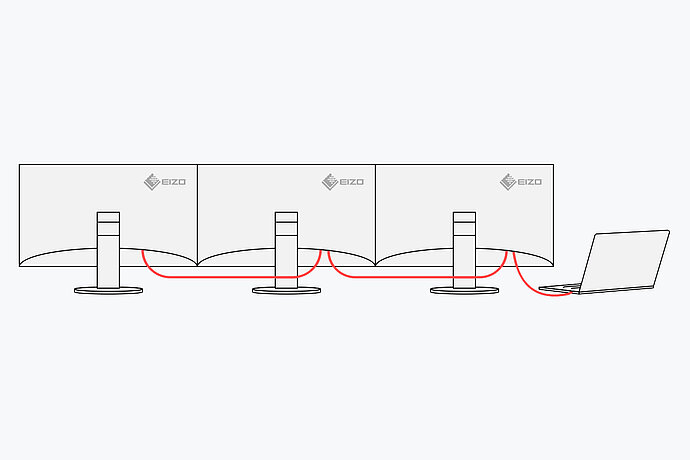
Daisy chain: neat cable management
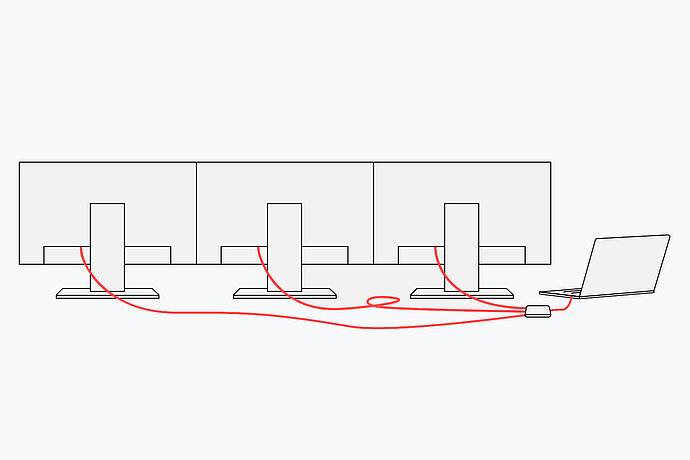
Conventional solution: messy cabling
Data signals
A suitably equipped monitor can be used as a USB docking station for accessories such as a keyboard, mouse, webcam and similar components without the need to connect additional cables. A stable network connection is also possible via a LAN connection directly on the monitor. The practical operation of several PCs is possible with certain models thanks to the KVM switch.
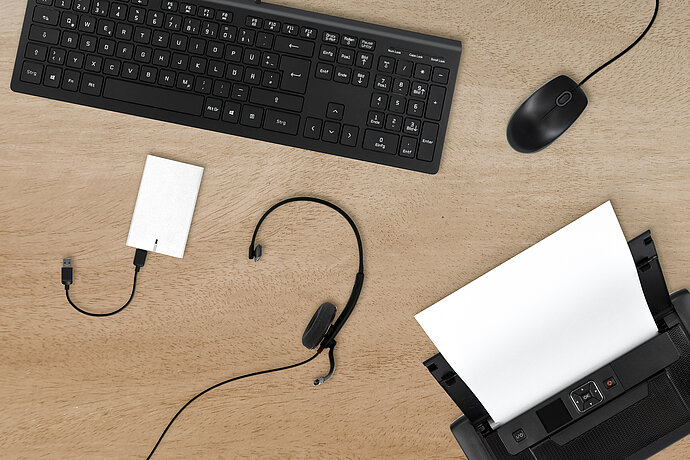
Connect peripheral devices directly to the monitor
In order to be able to work as comfortably as possible in the home office, it is a great advantage if the monitor has an integrated USB hub. This allows you to keep the USB devices you need at home (such as a mouse and keyboard, headset or card reader) connected directly to the monitor instead of having to connect them to the notebook individually and laboriously each time.
If you can connect the monitor via USB-C, no additional cable is required. The data connection then runs via the USB-C cable in addition to the image signal. If you use HDMI or DisplayPort, a single USB cable is sufficient to connect all peripheral devices connected to the monitor to the computer.
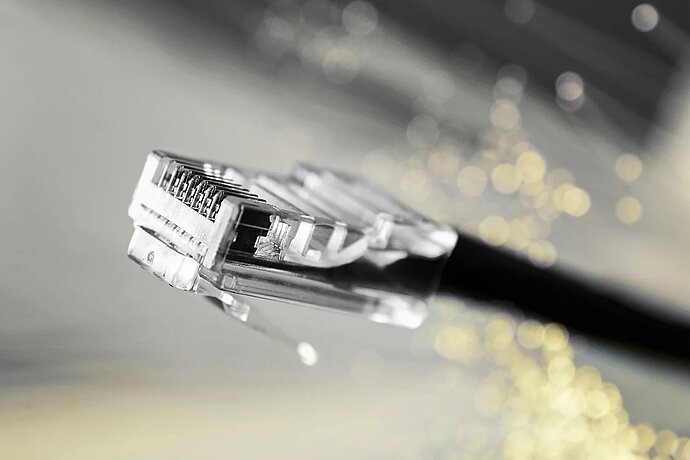
For a stable network connection
If the monitor also has an integrated LAN connection, the internet and network signal can even be transmitted via the USB-C connection.
Notebooks or PCs only need to be connected with a USB-C cable to access the network signal via the monitor. This is a particular advantage for notebooks that no longer have a LAN connection. This enables fast and stable data transfer, as required for video conferences, for example.
KVM switch
If you want to use a mouse and keyboard on several computers (e.g. on a desktop PC and notebook), you should make sure that your monitor has a KVM (keyboard, video, mouse) switch. This automatically connects the mouse and keyboard to the computer currently activated on the monitor.
In the home office, for example, the private PC and company computer can share the monitor as well as the keyboard and mouse connected to it and even other linked monitors.
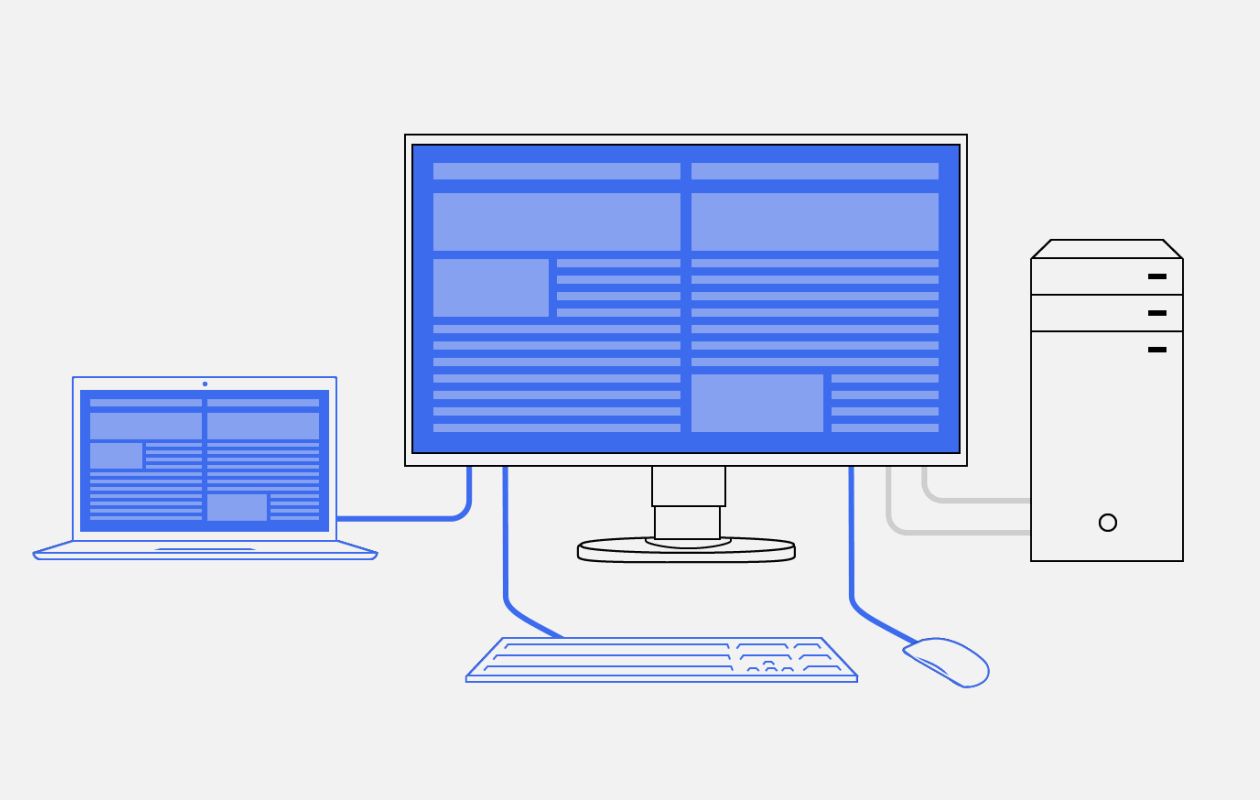
Power supply
It is even possible to supply the connected computer with power and charge it via USB-C if the monitor has a corresponding power delivery function (PD).
This even makes connecting a power adapter to the notebook or tablet obsolete. So forget the hassle of transporting your notebook charging cable and benefit from more space on your desk.

MONITORS IN THE HOME OFFICE
The ergonomic workplace
In addition to a clear and high-contrast display, a good monitor is characterized above all by the fact that it is easy on the back and eyes. After all, it is well known that prolonged screen work can lead to "tired" eyes or tension. There are a number of possible reasons for this.
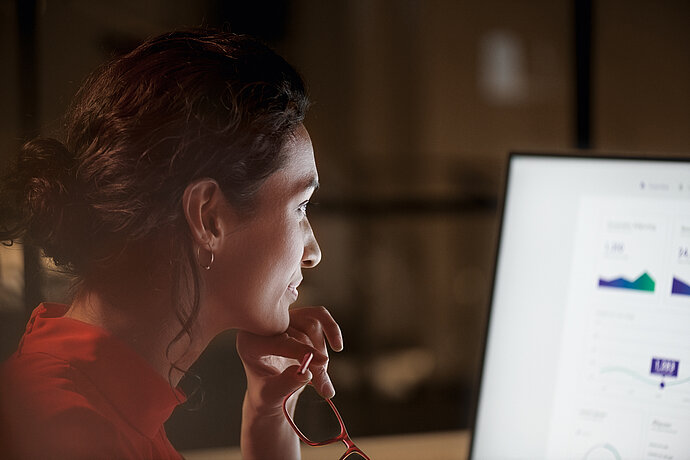
Flicker-free: for the sake of your eyes
Flickering screens are particularly problematic. The extent to which a monitor flickers depends on how the backlight is dimmed and controlled during operation. Due to the brightness control, many LED backlights shine at frequencies that particularly sensitive people perceive as flickering. However, you can work on a flicker-free screen for longer periods of time without eye fatigue, headaches and other physical impairments.

More image, less reflection
The monitor image should always be easy to read. Unfortunately, many monitors or notebooks have glossy display panels. Sometimes there is even reflective protective glass in front of the actual panel. This leads to unwanted reflections. In addition to the actual monitor image, you can often see reflections from lamps or windows behind the viewer, or even yourself. These unnecessary disturbing influences make screen work considerably more strenuous, are distracting and, in the worst case, can even lead to postural problems. To avoid such annoying reflections, you should make sure that the monitor used in the home office has a matt panel surface and is therefore effectively anti-reflective.
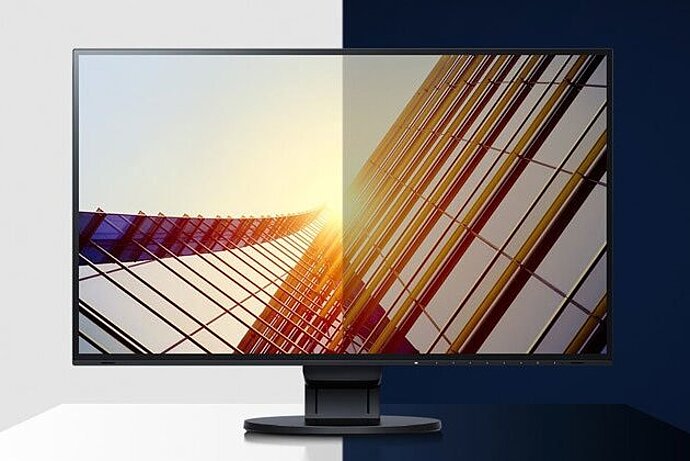
Ergonomic and environmentally friendly
Another decisive ergonomic advantage is automatic brightness control. This means that an ergonomic office monitor should automatically adjust the image brightness to the lighting conditions around the monitor depending on the time of day or lighting situation. Dynamic readjustment of this kind improves legibility and ensures that users are not "dazzled" or that the monitor is set too dark. Such a function reduces eye fatigue and also saves energy.
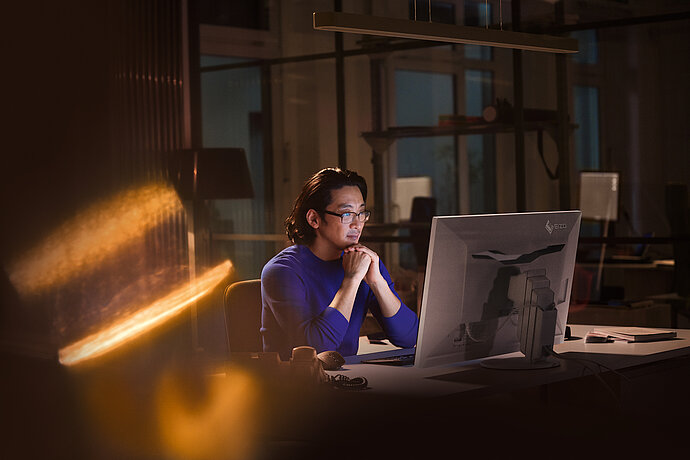
A difference like day and night
Working from home sometimes involves sitting down at the monitor in the evening and wanting to go to sleep soon afterwards. A function for daily rhythmic dimming helps to avoid disturbing the natural day-night rhythm. This takes into account our different requirements during the course of the day ("Circadian Dimming") and allows the colors to be adapted to your internal clock. While the color temperature is higher during the day, it is reduced in the evening.
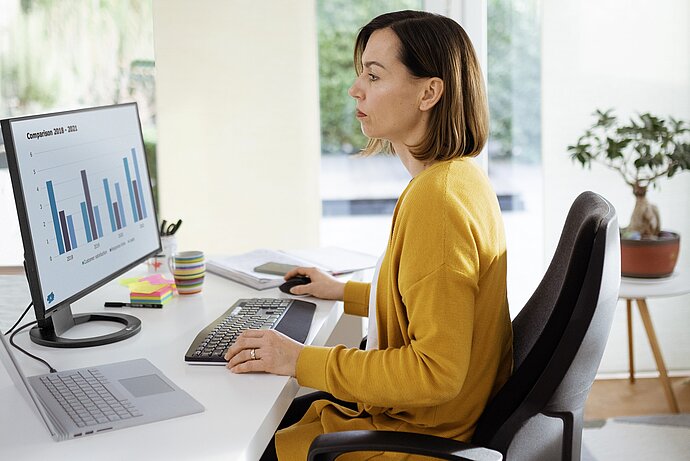
A question of attitude
Back and neck pain are among the most widespread health problems of our time. Working people are particularly frequently affected, as working in an uncomfortable or simply unhealthy posture is one of the possible causes. The right monitor makes a decisive contribution here, as every person has individual physical characteristics and needs. While notebook monitors can at best be adjusted in terms of tilt, external monitors can be optimally adapted to your individual preferences in terms of height, tilt and rotation to allow you to work both sitting and standing.
Monitors in the home office
Sustainable and economical monitors
When you choose quality monitors from EIZO, you are choosing cost-effectiveness and sustainability in equal measure. Whether you work in the office or from home more often in the future, EIZO will get you ready for "New Work" - especially in the long term. Thanks to their high-end materials and components as well as EIZO's special manufacturing and quality assurance processes, our monitors guarantee you a significantly longer service life than usual.
Each of our FlexScan models comes with a 5-year warranty including on-site replacement service - which means one thing above all else for you: maximum investment security.

